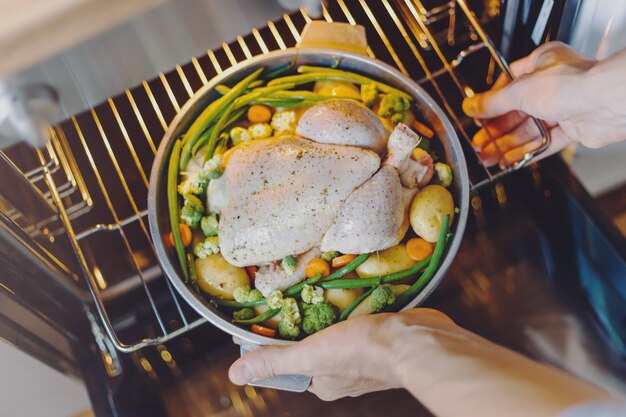If you want to cook a delicious silver tip roast, you need to know the right techniques. Choosing the perfect cut, preparing the roast, seasoning and marinating, cooking techniques, and resting and carving are all important steps in achieving a mouthwatering result.
In this guide, we will walk you through each step, providing clear and concise instructions to help you master the art of cooking a silver tip roast. From selecting the best cut of meat to properly seasoning and cooking it, you’ll learn all the tips and tricks to ensure a tender and flavorful roast every time. So, let’s get started and turn your silver tip roast into a culinary masterpiece.

Choosing the Perfect Cut
- To choose the perfect cut for your silver tip roast, start by looking for a well-marbled piece of meat at your local butcher or grocery store. The marbling, or the streaks of fat that run through the meat, is important because it adds flavor and helps keep the roast moist during cooking. Look for a roast that has a good amount of marbling throughout, as this will ensure a tender and juicy result.
- When it comes to seasoning your silver tip roast, simplicity is key. A classic combination of salt, pepper, and garlic will enhance the natural flavors of the meat without overpowering it. You can also experiment with different herbs and spices to add your own personal touch.
- When choosing the best cooking method for your silver tip roast, consider factors such as time and temperature. For a tender and juicy roast, low and slow is the way to go. Roasting the meat at a lower temperature for a longer period of time will allow the connective tissues to break down, resulting in a more tender and flavorful roast.
Preparing the Roast
- Start by trimming any excess fat from the silver tip roast. This will help prevent the roast from becoming too greasy during cooking. Once the fat has been trimmed, you can decide whether you want to braise or roast the roast. Braising involves cooking the roast slowly in a liquid, such as broth or wine, while roasting involves cooking the roast uncovered in the oven.
- Both methods yield delicious results, but braising tends to result in a more tender and moist roast, while roasting creates a flavorful crust on the outside. Whichever method you choose, it’s important to select the right cooking temperature. For braising, a low temperature around 300°F (150°C) works best, while roasting requires a higher temperature of around 375°F (190°C).
Seasoning and Marinating
- Now it’s time to season and marinate your silver tip roast. The marinade options for your roast are endless, allowing you to customize the flavor profile to your liking. Consider a classic combination of garlic, rosemary, and thyme for a traditional taste.
- For a bolder flavor, try a marinade with soy sauce, ginger, and honey. You can also experiment with different herbs and spices like paprika, cumin, or chili powder to add a touch of heat. Whichever marinade you choose, make sure to generously coat the roast and let it marinate in the refrigerator for at least 4 hours or overnight for maximum flavor penetration. This step will enhance the taste and tenderness of your silver tip roast, resulting in a mouthwatering meal.
Cooking Techniques
- After marinating your silver tip roast, it’s time to move on to the cooking techniques. There are several different cooking methods you can choose from to prepare your roast. One popular method is oven roasting. Preheat your oven to the recommended temperature of 325°F (163°C). Place the roast on a rack in a shallow roasting pan and cook until the internal temperature reaches your desired level of doneness.
- Another option is grilling. Heat your grill to medium-high heat and sear the roast on all sides before moving it to indirect heat to finish cooking. You can also use a slow cooker or pressure cooker for a more tender result. Regardless of the cooking method you choose, proper temperature control is crucial to ensure a perfectly cooked silver tip roast. Use a meat thermometer to monitor the internal temperature and remove the roast from the heat when it reaches the recommended temperature.
Resting and Carving
- To rest and carve your silver tip roast, remove it from the heat and allow it to sit for at least 15 minutes before slicing. This resting time is crucial as it allows the juices to redistribute throughout the meat, resulting in a more tender and flavorful roast. During this resting period, cover the roast loosely with foil to keep it warm.
- Once the resting time is complete, it’s time to carve the roast. Start by placing the roast on a cutting board and using a sharp carving knife, slice against the grain. This ensures that each slice is tender and easy to chew. Make sure to cut thin slices, about ¼ inch thick, for the best results. Serve immediately and enjoy your perfectly cooked silver tip roast.
Conclusion
In conclusion, cooking a silver tip roast requires careful selection of the cut, proper preparation, seasoning, and marinating techniques. Various cooking techniques can be employed, such as roasting or braising, to ensure a tender and flavorful roast. After cooking, allowing the roast to rest before carving is crucial to retain its juiciness. By following these steps with precision and attention to detail, you can enjoy a perfectly cooked silver tip roast that will impress your guests.


